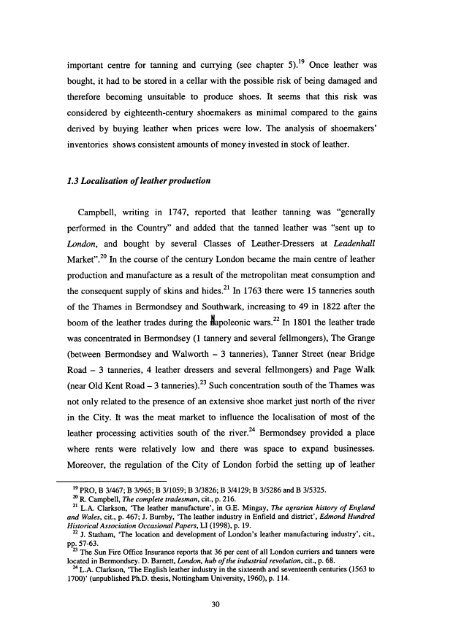The Boot and Shoe Trades in London and Paris in the Long Eighteenth Century
The Boot and Shoe Trades in London and Paris in the Long Eighteenth Century
The Boot and Shoe Trades in London and Paris in the Long Eighteenth Century
Create successful ePaper yourself
Turn your PDF publications into a flip-book with our unique Google optimized e-Paper software.
important centre for tann<strong>in</strong>g <strong>and</strong> curry<strong>in</strong>g (see chapter 5)•19 Once lea<strong>the</strong>r was<br />
bought, it had to be stored <strong>in</strong> a cellar with <strong>the</strong> possible risk of be<strong>in</strong>g damaged <strong>and</strong><br />
<strong>the</strong>refore becom<strong>in</strong>g unsuitable to produce shoes. It seems that this risk was<br />
considered by eighteenth-century shoemakers as m<strong>in</strong>imal compared to <strong>the</strong> ga<strong>in</strong>s<br />
derived by buy<strong>in</strong>g lea<strong>the</strong>r when prices were low. <strong>The</strong> analysis of shoemakers'<br />
<strong>in</strong>ventories shows consistent amounts of money <strong>in</strong>vested <strong>in</strong> stock of lea<strong>the</strong>r.<br />
1.3 Localisation of lea<strong>the</strong>r production<br />
Campbell, writ<strong>in</strong>g <strong>in</strong> 1747, reported that lea<strong>the</strong>r tann<strong>in</strong>g was "generally<br />
performed <strong>in</strong> <strong>the</strong> Country" <strong>and</strong> added that <strong>the</strong> tanned lea<strong>the</strong>r was "sent up to<br />
<strong>London</strong>, <strong>and</strong> bought by several Classes of Lea<strong>the</strong>r-Dressers at Leadenhall<br />
Market". 2° In <strong>the</strong> course of <strong>the</strong> century <strong>London</strong> became <strong>the</strong> ma<strong>in</strong> centre of lea<strong>the</strong>r<br />
production <strong>and</strong> manufacture as a result of <strong>the</strong> metropolitan meat consumption <strong>and</strong><br />
<strong>the</strong> consequent supply of sk<strong>in</strong>s <strong>and</strong> hides. 21 In 1763 <strong>the</strong>re were 15 tanneries south<br />
of <strong>the</strong> Thames <strong>in</strong> Bermondsey <strong>and</strong> Southwark, <strong>in</strong>creas<strong>in</strong>g to 49 <strong>in</strong> 1822 after <strong>the</strong><br />
boom of <strong>the</strong> lea<strong>the</strong>r trades dur<strong>in</strong>g <strong>the</strong> Ilapoleonic wars. 22 In 1801 <strong>the</strong> lea<strong>the</strong>r trade<br />
was concentrated <strong>in</strong> Bermondsey (1 tannery <strong>and</strong> several feilmongers), <strong>The</strong> Grange<br />
(between Bermondsey <strong>and</strong> Walworth - 3 tanneries), Tanner Street (near Bridge<br />
Road - 3 tanneries, 4 lea<strong>the</strong>r dressers <strong>and</strong> several felimongers) <strong>and</strong> Page Walk<br />
(near Old Kent Road - 3 tanneries). 23 Such concentration south of <strong>the</strong> Thames was<br />
not only related to <strong>the</strong> presence of an extensive shoe market just north of <strong>the</strong> river<br />
<strong>in</strong> <strong>the</strong> City. It was <strong>the</strong> meat market to <strong>in</strong>fluence <strong>the</strong> localisation of most of <strong>the</strong><br />
lea<strong>the</strong>r process<strong>in</strong>g activities south of <strong>the</strong> river. 24 Bermondsey provided a place<br />
where rents were relatively low <strong>and</strong> <strong>the</strong>re was space to exp<strong>and</strong> bus<strong>in</strong>esses.<br />
Moreover, <strong>the</strong> regulation of <strong>the</strong> City of <strong>London</strong> forbid <strong>the</strong> sett<strong>in</strong>g up of lea<strong>the</strong>r<br />
' 9 PRO, B 3/467; B 3/965; B 3/1059; B 3/3826; B 3/4129; B 3/5286 <strong>and</strong> B 3/5325.<br />
20 R. Campbell, <strong>The</strong> complete tradesman, cit., p. 216.<br />
21<br />
L.A. Clarkson, '<strong>The</strong> lea<strong>the</strong>r manufacture', <strong>in</strong> G.E. M<strong>in</strong>gay, <strong>The</strong> agrarian history of Engl<strong>and</strong><br />
<strong>and</strong> Wales, cit., p. 467; J. Burnby, '<strong>The</strong> lea<strong>the</strong>r <strong>in</strong>dustry <strong>in</strong> Enfield <strong>and</strong> district', Edmond Hundred<br />
Historical Association Occasional Papers, LI (1998), p. 19.<br />
22<br />
j Statham, '<strong>The</strong> location <strong>and</strong> development of <strong>London</strong>'s lea<strong>the</strong>r manufactur<strong>in</strong>g <strong>in</strong>dustry', cit.,<br />
pp. 57-63.<br />
<strong>The</strong> Sun Fire Office Insurance reports that 36 per cent of all <strong>London</strong> curriers <strong>and</strong> tanners were<br />
located <strong>in</strong> Bermondsey. D. Barnett, <strong>London</strong>, hub of <strong>the</strong> <strong>in</strong>dustrial revolution, cit., p. 68.<br />
24 L.A. Clarkson, '<strong>The</strong> English lea<strong>the</strong>r <strong>in</strong>dustry <strong>in</strong> <strong>the</strong> sixteenth <strong>and</strong> seventeenth centuries (1563 to<br />
1700)' (unpublished Ph.D. <strong>the</strong>sis, Nott<strong>in</strong>gham University, 1960), p. 114.<br />
30


